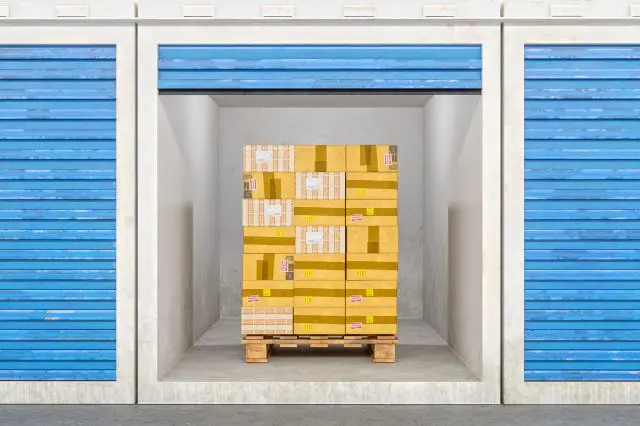Business
Compass Self Storage Review: A Beneficial Guide

Self-storage units in Canada, the USA, the UK and other big countries are gaining ground nowadays. This is mostly accredited to their versatile uses, efficiency and the resulting demand. The requirement of extra storage space, and people’s willingness to pay for the same forms the basis of the self-storage industry.
Self-storage facilities all over the world provide interested individuals with rentable units to store their belongings. The top self-storage units further provide customers with extra features like on-site supplies for sale, climate controlled storage units at a slightly higher rent, 24/7 video surveillance and so on.
Most people require storage units to store their household belongings while they downsize, or vehicle parking or even business documents and inventory. But storage spaces can also be used for temperature-sensitive objects, crafted items, paintings, expensive antiques or jewellery, appliances, etc.
Compass self-storage is a self-storage company in Canada which provides similar storage services to customers in need. And I will be reviewing and detailing the sort of services they seem to provide. So let us start from the first and foremost interface that a customer interacts with in order to find a suitable unit, their website.
Website
With a dark blue colour palette with some touches of a shade of bright yellow, their home page seems to be a hub of information about the various services they provide. The website home page seems to simplify all their services provided.
The information is displayed in a way that is easily comprehensible and navigable by even the least tech-savvy persons. The Home page also contains a brief introduction about why they are the ideal storage company, as well as an About Compass section at the top right corner.
The company has locations scattered across the Eastern Seaboards and the Midwestern states. Compass self-storage is a member of the Amsdell family of companies which is headquartered in Cleveland, OH.
Features and Tools
The website really makes looking for the perfect storage space much easier than the traditional way. The first thing a visitor sees on the website is the Search bar which allows one to search for facilities by City, State or Zip code, and the distance between the facility and the area.
While the former of these two tools is usually present in most companies’ websites, the Distance tool is rather rare and not provided in most of the websites that I have come across and reviewed.
Further the website provides clickable Infographics which take you to Unit Size guides, Packing supplies information and Truck Rental service guides. The Size guide provides an estimate of a the space that the unit provides, as well as the sort of stuff that you can store in the unit. The Packing supplies page has information about the supplies that they sell.
From moving boxes of various sizes to shrink wrap, they have all the trinkets one could need for a safe wrapping and moving session. The Truck rental page tells us about how to rent a Moving truck from their site. It also has specifications and information about truck sizes and other services they offer.
Further, the company also provides Personal, Business and Boat and RV storage, like some of the top self-storage facilities in the country. Again, the graphics are clickable and take you directly to the respective pages.
Their unit features include Drive-up and indoor unit access, climate controlled units, extensive access hours, electronic gate access, cctv, etc. Scrolling down till the end of the page reveals that they also provide pharmaceutical storage and small business storage. Both of these are perfect to store shipment and inventory when they are not needed.
Sizes
Compass Self storage provides a plethora of sizes to choose from. You can access their size guide and decide which one seems the most suitable for your belongings. Compass, like most of the largest self storage companies, provides standard sizes. The 5’ x 5 unit has 25 sq. ft. of space while the 5’ x 10’ provides 50 square foot. The 10’ x 10’ unit has a 100 square foot of space, the 10’ x 15’ has 150 sq. ft. and so on. They also have 10’ x 20’ and 10’ x 30’ units. But these are just the most common sizes. They also provide sizes that lie in between these dimensions. For example, units like 5’ x 7’, 8’ x 5’, 6’ x 8’, etc.
Pricing
Like all self-storage companies, in Canada or USA of in any country, Compass self-storage prices their units at different values depending on the location and features. To give you a rough idea, the units in Montgomery, Alabama on 4220 Troy Hwy, start from $25 at the lowest, for a 5’ x 5’ sized non-climate-controlled unit. The same unit, when climate-controlled, costs $48 a month. Further, the prices increase with an increase in the size and features. The largest normal unit lies at $469 while providing the customer with 800 square foot of space. Further, some selected units can be rented out for free for the first month, almost like a trial for the customer to make a decision upon.
On the contrary, units in the Compass facility at 200 S. Arrowhead Dr.Montgomery, Alabama, have much higher prices. The 5’ x 5’ unit starts at $64, and goes on increasing. Their largest climate controlled unit has dimensions 10’ x 30’ and is costs $425 a month. That is a shocking increase in comparison to the former facility.
Customer Reviews
Customer reviews are an indispensable way of gaining ground for companies. Reviews are undoubtedly one of the best ways to judge a company, other than using its services and judging it. And Compass Storage proudly displays its reviews on its website. One customer praised the friendly service, along with the clean and easily accessible facility. While another customer showered the company with love and portrayed his gratefulness for the years worth of fantastic service that he received.
But usually, companies prefer to highlight their best reviews on their website while hiding their criticisms. Hence an unbiased source is necessary to have an impartial judgement. And for us, this source is Trustpilot and the reviews received by Compass self storage. They have received almost 2 thousand reviews on Trustpilot, and about 78% of the lot says the company is excellent. From their service, to security, organisation and professionalism, everything has been praised. But alongside, a ton of the customers are unhappy with the frequent rate increases and hidden fees. About 7% of the total reviews are negative and complain about the high rates. There are also some reviews mentioning the last minute rate changes and similar debauchery that they have faced.
In Conclusion
It looks like Compass Self storage has some fans and some haters, which is fairly normal for every company. Depending on your requirements and budget, it would be best to read all documents carefully. Be sure of all your expenses before you seal the deal. You can also check out their blog which has articles about moving with pets, home business related posts and the like.
And if you don’t find a suitable unit at Compass Self storage, make sure to check out our review about Atlantic Self-Storage,(enter article link), USA. Happy storing!
Finance
4 Reasons You Should Care about Your Credit Score


If applying for a small business loan, your credit score can make or break your chances of securing one and getting a good interest rate.
Whether starting a business, looking to expand, or requiring funds for other purposes, you may one day need a business loan. Getting the best terms possible is a priority. That’s one reason to consider your creditor score and how it’ll factor into your search for a business loan.
Here are four reasons your credit score matters. You’ll also see how to get help with credit score disputes if you can’t resolve such conflicts independently.
1. Credit Score Determines If You Get a Business Loan
If getting a business loan is a make-or-break issue for your company, you should be mindful of your credit score. Remember that lenders aren’t in the business of offering loans to people who present a substantial risk.
So, if your credit score is less than optimal, lenders could balk at lending you a loan or offer less money to reduce their risk. It’s a good idea to consider your credit score to see if you can realistically qualify for a business loan with reasonable terms.
Otherwise, you may have to explore other options to secure money for business needs. There are alternative ways to get funds. But it might mean accepting a higher interest rate or onerous terms.
2. Credit Score Affects Your Interest Rate
Even if you qualify for a business loan, you may not get a good interest rate if your credit score isn’t good. Even a few percentage points more could translate into paying back thousands more to complete your payback obligations.
You’ll have to consider whether you can afford to shoulder a high premium in interest payments to get a business loan you might not qualify for otherwise.
If forced to pay higher interest for a business loan, the lender may have other stringent terms. You should carefully consider the particulars before signing on the dotted line.
3. Credit Score Can Impact How Much You Qualify for
As was mentioned above, your credit score can influence how much a lender is willing to lend. If your credit is not good enough to grant you the amount you want, a lender may offer a business loan for a fraction of that sum.
That can happen when a lender doesn’t feel comfortable enough lending you more than a specific amount. It’s about limiting the potential fallout if you’re unable to pay your loan.
When a lender looks at your finances, it’ll know how much you can afford to pay back. If it determines you’ll struggle to pay back the amount you request, it might simply offer a lower amount more in line with your cash flow.
4. Credit Score Can Throw a Wrench in Your Business Plans
You may struggle to grow your business if you desperately need a business loan but have poor credit. In fact, you may face financial problems that threaten the long-term viability of your company. So, your credit score can make or break your business. Don’t allow bad credit to throw a wrench into your plans. If possible, improve your credit score before applying for a loan.
While a bad credit score can cause problems for your business, there are times when your credit report may include inaccurate information. Whether the credit report hasn’t been updated or includes completely false information, you may struggle to get the information corrected.
If you can’t make progress on this front, you may need to speak to a lawyer. A legal professional experienced in helping clients involved in credit score disputes can be a godsend.
Business
How Has E-commerce Evolved?


E-commerce has a relatively short history in business. The earliest incarnations of e-commerce stretch back to the 1970s, when early technologies such as teleshopping and Electronic Data Interchange helped to create a primitive version of this form of commerce.
However, modern e-commerce started to take off in 1994 when the entrepreneur Jeff Bezos set up Amazon from his garage. Initially, Amazon was an online marketplace just for books. In the years that followed, the range of products available increased.
Today, millions of unique products can be bought on the site, which has led it to become known as “the everything store.” Today, there are estimated to be over 26 million e-commerce websites worldwide, with around 13 million based in the US.
The e-commerce sector has grown rapidly and is predicted to continue to enjoy year-on-year growth for the foreseeable future.
However, in its relatively short history, there have been several developments that have shaped how companies operate online. In addition, consumer behavior and shopping preferences have changed as people regularly buy products and services online.
In this article, there will be a discussion of how e-commerce has evolved. Some key examples will be used to support this.
Social media promotion is integral to the sector
In the early days of e-commerce, there was far less competition between businesses because there were far fewer e-commerce firms. The internet has grown at an exponential rate since the early 1990s, and consumers can now find virtually any product, service, or specialist e-commerce firm online.
Due to the massive growth in the e-commerce sector, online firms now need to have a comprehensive marketing plan to promote their site and their products. This is vital to allow companies to stand out in an increasingly crowded online marketplace.
A key marketing strategy for millions of e-commerce firms is leveraging social media promotion’s power. Popular social media sites such as TikTok have around 1 billion monthly users, which makes the site a prime avenue for online promotions.
There is a global community of visitors to the site, which encompasses a wide range of demographics and target markets. Today, most e-commerce sites will have a marketing budget specifically for social media promotions.
They will create short but memorable adverts (typically using video) and will ensure that a hyperlink is embedded in the advert that takes the viewer to the product page of their website.
This simple strategy transforms customer interest into a sale with the lowest number of steps required on the part of the consumer. In short, social media promotion is a vital activity for any e-commerce firm and helps them to stand out in an increasingly crowded online marketplace.
The changing attitudes to delivery
In the early years of e-commerce, consumers understood that delivery timescales may be relatively long. Many customers were starting to buy from international sellers or fledgling e-commerce firms in their own country. During the early stages of e-commerce, there were few advanced delivery networks for online firms.
During the 1990s typical delivery timescales were far longer than today. Most products would take at least five days to arrive and potentially could be in transit for weeks.
Whilst consumers tolerated these timescales in the early days of e-commerce, they now expect quicker delivery schedules. In addition, if the stated delivery period is not adhered to and there are delays, many customers will stop using the e-commerce site.
As consumer delivery expectations increase, e-commerce firms must ensure that they can work with dependable and efficient shipping and courier firms. Companies such as Shiply USA may be ideal for smaller e-commerce firms that do not have their own delivery networks.
Such firms can offer highly competitive prices for shipping a range of goods. In addition, they have built a reputation for delivering to pre-stated timescales, with minimal levels of damage to items in transit.
In short, all e-commerce firms need to forge strong working relationships with professional shipping firms who can deliver on time and with competitive fees.
The rise of chatbots in online customer service
Finally, modern online shoppers expect that any queries or questions that they may have will be answered swiftly with excellent customer service. Not receiving a timely response to their correspondence creates a negative perception of the company and may make them less likely to purchase from the site.
E-commerce firms have been quick to recognize the value of swift responses to customer queries and are increasingly using AI to facilitate this. Chatbots are now widely used in e-commerce. They are programmed to understand language and detect the key question raised, directing customers to specific web pages with information on the topic.
This can help customers get the information they need and reduce the reliance on a large human customer service team, keeping such staffing costs low.
Business
8 Tips for Better Product Consistency


When it comes to building a business that people trust and recognize, there’s no replacement for consistency. More specifically, you need the quality and output of your products to be consistent across the board.
However, with so many different moving parts involved, this is often easier said than done.
- Standardize Your Processes
Start by examining your current processes and how things are being handled at every step of the production process:
- Are they documented?
- Where are they documented?
- Is there a clear blueprint that everyone can follow?
Standardization is the backbone of consistency. It involves setting clear guidelines for every stage of your production, from the initial design to the final output. This means having detailed, step-by-step instructions that leave no room for ambiguity.
It’s a smart idea to implement checklists and workflows, which are easy for people to follow. This ensures every product goes through the same procedure, minimizing variations that can lead to inconsistencies.
- Implement Rigorous Quality Control
Quality control is non-negotiable. With that in mind, introduce systems that scrutinize your products at multiple stages of the production process. This might involve regular spot checks, pre-shipment inspections, and even post-market quality assessments.
The goal of quality control is to catch and address any deviations before they reach the customer. Consider adopting statistical quality control techniques like Six Sigma, which can help you measure, analyze, and reduce variability in your manufacturing process.
- Leverage Technology and Automation
Don’t ignore the resources you have available at your fingertips. This includes technology and access to outside partners.
In terms of tech, automation has the ability to reduce human error and ensure that each part of your product meets exact specifications. When it comes to outside partners, you can always hand off parts of your process to an experienced contract assembly company to make sure you get the same result every single time a product is packaged.
- Train and Engage Your Employees
Your employees are the real MVPs behind your product, and their skills and commitment play a pivotal role in consistency. Even if the majority of the production is happening with the help of automation, it ultimately comes down to the people who are implementing the systems, spot-checking the production processes, and keeping everything running.
The best thing you can do is invest in comprehensive training programs that teach your employees about the technical aspects of their jobs while instilling a deep understanding of the importance of consistency. Engaged employees who share a commitment to your brand’s standards are less likely to cut corners and more likely to maintain high quality in every task they perform.
- Gather and Utilize Feedback
Feedback is a powerful tool – don’t ever forget it. While not always comfortable – and quite often painful – gathering feedback forces you to come eye-to-eye with how you’re actually doing. (Not just how you think you’re doing.)
Gather input from your customers, employees, and even suppliers on a regular basis to find out where there might be inconsistencies in your product. This can provide invaluable insights into areas that may need adjustment. Use this feedback to fine-tune your processes and training, ensuring that your products continually meet customer expectations and industry standards.
- Monitor and Adapt Your Supply Chain
The consistency of your product is also highly dependent on the materials you use. Variability in materials can lead to variability in the final product. Keeping this in mind, build strong relationships with reliable suppliers whose products meet your quality standards.
Regular audits and supplier evaluations can also go a long way towards helping ensure that the materials you receive remain consistent in quality and function.
- Set Realistic and Clear Expectations
While striving for perfection, set realistic expectations for your team and your processes. This might seem like an oxymoron, but it’s all about your mentality. Perfection is always the goal, but you also have to remember that people are people – meaning they will make mistakes.
Don’t accept these mistakes, but also don’t ruin relationships when people don’t live up to the goal of perfection. Instead, go back to the drawing board and find ways to limit those mistakes in the future.
- Prioritize Continuous Improvement
The journey to product consistency is one that never ends. Markets evolve, technologies advance, and customer preferences change. Maintain a mindset of continuous improvement, regularly reviewing and refining your processes to adapt to new challenges and opportunities.
This proactive approach will keep you ahead of the curve, ensuring your products consistently meet the high standards your customers expect.
Invest in Consistency
If you make a commitment to product consistency, you’ll never regret it – not even for a day. It can be costly and time-consuming on the front end, but it’s one of the most financially rewarding investments you’ll ever make in the long run.
Start with the tips highlighted in this article and begin shifting your focus in a new direction!
-



 Captions3 years ago
Captions3 years ago341 Sexy Captions to Fire Up Your Instagram Pictures
-



 Captions3 years ago
Captions3 years ago311 Night Out Captions for Instagram and Your Crazy Night
-



 Captions3 years ago
Captions3 years ago245 Saree Captions for Instagram to Boost Your Selfies in Saree
-



 Captions3 years ago
Captions3 years ago256 Best Ethnic Wear Captions for Instagram on Traditional Dress
-



 Captions3 years ago
Captions3 years ago230 Blurred Picture Captions for Instagram
-



 Captions3 years ago
Captions3 years ago275 Deep Captions for Instagram to Express Your Thoughts
-



 Quotes3 years ago
Quotes3 years ago222 Nail Captions for Instagram to Showcase Your Fresh Manicure
-



 Captions3 years ago
Captions3 years ago211 Laughing Captions for Instagram | Laughter Is the Best Medicine







